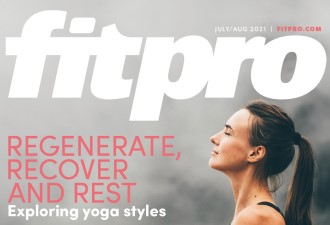Magazine References
Jul – Aug 2021

Pg 6-7: Pivoting fitness to a healthcare option
References
- Owen N et al (2020), Sedentary behavior and public health: Integrating the evidence and Identifying potential solutions, Annu Rev Public Health, 2, 41: 265-287.
- Nuffield Health, T he new health pandemic: over 7 in 10 Britons aren’t exercising enough, a quarter of over 55s have done no exercise AT ALL since COVID-19 hit and 41% say mental health is worse: www.nuffieldhealth.com/article/the-new-health-pandemic-over-7-in-10-britons-arent-exercising-enough-a-quarter-of-over-55s-have-done-no-exercise-at-all-since-covid-19-hit-and-41-say-mental-health-is-worse, accessed on 17 June 2021.
- Fulmer et al (2021), Actualizing better health and health care for older adults, Health Affairs, 40: 2.
- Hamilton M et al (2004), Exercise physiology versus inactivity physiology: An essential concept for understanding lipoprotein lipase regulation, Exer Sport Sci Rev., 32(4): 161-166.
- Bull FG et al (2020), World Health Organization 2020 guidelines on physical activity and sedentary behaviour, Br J Sports Med., 54: 1,451-62.
Pg 8-10 Yoga: A simple regeneration activity or a deeper practice?
References
- https://www.sciencedirect.com/science/article/abs/pii/S1053810012000165, accessed on 27 May 2021.
- https://www.ncbi.nlm.nih.gov/books/NBK539845/, accessed on 27 May 2021.
- https://jivamuktiyoga.com/jivamukti-yoga-classes/jivamukti-beginner-vinyasa-class-curriculum/, accessed on 27 May 2021.
- https://www.youtube.com/watch?v=pdiu_XaZHNM, accessed on 27 May 2021.
- https://pubmed.ncbi.nlm.nih.gov/28963884/, accessed on 27 May 2021.
- https://jivamuktiyoga.com/fotm/asana-0/, accessed on 27 May 2021.
- Sri Swami Satchidananda (2012), The Yoga Sutras of Patanjali, Chapter 2, Sutra 46.
Pg 31-33 Managing the menopause
References
- National Center for Complementary and Alternative Medicine (2019), Menopausal Symptoms and Complementary Health Practices [online], available from https://nccih.nih.gov/health/menopause/menopausesymptoms, accessed on 17 June 2021.
- National Institute for Health and Clinical Excellence (2015), Menopause: diagnosis and management (NG23), plus (2017) Menopause (QS143).
- Moslehi N et al (2017), Current evidence on association of nutritional factors with ovarian reserve and timing of menopause: a systematic review, Adv Nutr., 597-612.
- Johnson et al (2019), Complementary and alternative medicine for menopause, J Evid Based Integr Med.
- Hazel A (2019), Hot flashes. A review of the literature on alternative and complementary treatment approaches, J Evid Based Integr. Med., 24: 2515690.
- Bedell S, Nachtigall M, Naftolin F (2014), The pros and cons of plant estrogens for menopause, J Steroid Biochem Mol Biol., 139: 225-36. doi: 10.1016/j.jsbmb.2012.12.004
- British Dietetic Association, Menopause Food Facts.
- Franco OH et al (2016), Use of plant-based therapies and menopausal symptoms: a systematic review and meta-analysis, JAMA 315: 2554-2563, Crawford AL et al (2013), The impact of dose, frequency of administration, and equal production on efficacy of isoflavones for menopausal hot flashes: a pilot randomized trial, Menopause, 20: 911-921.
- Chen M et al (2015), Efficacy of phytoestrogens for menopausal symptoms: a meta-analysis and systematic review, Climacteric, 18(2): 260-9.
- Parikh M (2019), Dietary flaxseed as a strategy for improving human health, Nutrients, 25; 11(5): 1,171.
- Meng Q et al (2021), The gut microbiota during the progression of atherosclerosis in the perimenopausal period shoes specific compositional changes and significant correlations with circulating lipid metabolites, 13 (1-27).
Pg 32-33 Movement in sport: Improving co-ordination with ViPR
References
- Wulf G, Shea CH, Understanding the role of augmented feedback, the good, the bad and the ugly. In: Williams AM, Hodges NJ (Eds) (2004), Skill Acquisition in Sport, Research, Theory and Practice, New York: Routledge, 212-245.
- Bosch F (2020), Anatomy of Agility Movement Analysis in Sport, Publishers (Rotterdam, the Netherlands).
- Hommel B, Müsseler J, Aschersleben G, Prinz W (2001), The Theory of Event Coding (TEC): A framework for perception and action planning, Behavioral and Brain Sciences, 24: 849-937.
- Bosch F, Klomp R (2001), Running Biomechanics and Exercise Physiology Applied in Practice, Elsevier Churchill Livingstone, 349-350.
Pg 28-31 How to use movement screens to plan training
References
- Monaco JT, Schoenfeld BJ (2019), A review of the current literature on the utility of the functional movement screen as a screening tool to identify athletes’ risk for injury, Strength & Conditioning Journal, Oct 1; 41(5): 17-23.
- McKeown I, Taylor�McKeown K, Woods C, Ball N (2014), Athletic ability assessment: a movement assessment protocol for athletes, International Journal of Sports Physical Therapy, 9(7): 862.
- Myer GD, Ford KR, Hewett TE (2008), Tuck jump assessment for reducing anterior cruciate ligament injury risk, Athletic Therapy Today: The Journal for Sports Health Care Professionals, Sep 1; 13(5): 39.
- Bishop C, Read P, Chavda S, Turner A (2016), Asymmetries of the lower limb: the calculation conundrum in strength training and conditioning, Strength & Conditioning Journal, Dec 1; 38(6): 27-32.


